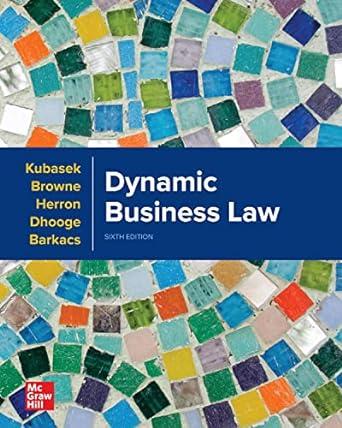Question
2012 Brian S. Batterton, Attorney, PATC Legal & Liability Risk Management Institute (www.llrmi.com) It is well known that police must provide suspects with Miranda warnings
2012 Brian S. Batterton, Attorney, PATC Legal & Liability Risk
Management Institute (www.llrmi.com)
It is well known that police must provide suspects with Miranda warnings for
custodial questioning. Further, before questioning, the suspect must waive his Fifth
Amendment rights after the warnings are given. However, sometimes, the specific
circumstances of an interview or interrogation provide some ambiguity as to
whether an interview is "custodial" or "non-custodial" for the purposes of Miranda.
Recently, the Fifth Circuit Court of Appeals decided United States v. Cavazos [i] which
offers police some guidance regarding whether or not an interview will be
considered "non-custodial" when conducted in the suspect's residence.
The facts of Cavazos are as follows:
On September 1, 2010, between 5:30 a.m. and 6:00 a.m., Cavazos woke to banging
on his door and the shining of flashlights through his window. U.S. Immigration and
Custom Enforcement ("ICE") Agents, assisted by U.S. Marshals, Texas Department of
Public Safety personnel, and Crane Sheriff's Department personnel, were executing
a search warrant on Cavazos's home. The warrant was issued on the belief that
Cavazos had been texting sexually explicit material to a minor female. After
Cavazos's wife answered the door, approximately fourteen law enforcement
personnel entered Cavazos's residence.
Immediately upon entering, government agents ran into Cavazos's bedroom,
identified him, and handcuffed him as he was stepping out of bed. Agents then let
Cavazos put on pants before taking him to his kitchen. Cavazos's wife and children
were taken to the living room. Cavazos remained handcuffed in the kitchen, away
from his family, while the entry team cleared and secured the home. ICE Agents Le
Andrew Mitchell and Eric Tarango then uncuffed Cavazos and sat with him in the
kitchen for approximately five minutes while other officers secured the home.
Once the house was secured, agent Tarango asked Cavazos if there was a private
room in which they could speak. Cavazos suggested his son's bedroom. In the
bedroom, Cavazos sat on the bed while the two agents sat in two chairs facing him.
The agents asked Cavazos if he wanted the door open, but Cavazos said to keep the
door closed. Agents Mitchell and Tarango informed Cavazos that this was a "non-
custodial interview," that he was free to get something to eat or drink during it, and
that he was free to use the bathroom. The agents then began questioning Cavazos
without reading him his Miranda rights.
The question is when does the functional equivalent of "custodial interrogation" take place? How does this case exemplify that premise?
how the functional equivalent of "custodial interrogation" may occur.
Step by Step Solution
3.40 Rating (163 Votes )
There are 3 Steps involved in it
Step: 1
The concept of the functional ...
Get Instant Access to Expert-Tailored Solutions
See step-by-step solutions with expert insights and AI powered tools for academic success
Step: 2

Step: 3

Ace Your Homework with AI
Get the answers you need in no time with our AI-driven, step-by-step assistance
Get Started


